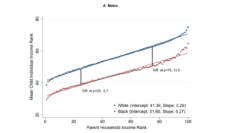Owning a home helps individuals accumulate wealth and pass that financial security on to their families. As a result, many view homeownership as an essential part of the American Dream.
However, the gap between White and Black homeowners has reached its widest margin in 50 years. As seen in the graph from the Urban Institute above, just 41.8% of Black families owned a home in 2017, 30% less than White families.
Since 2000, Black homeownership has decreased by 5%, while all other races and ethnicities saw gains or only marginal losses. If the rate had merely stayed the same after 2000, an additional 770,000 Black Americans would own a home.
The report links the gap to several factors, including income disparities. In 2017, the median income of Black households was 40% less than White households. The researchers estimate that reducing this income disparity would cut the homeownership racial gap by nearly a third.
Decades of racist and segregationist laws allowed White families to accumulate intergenerational wealth while prohibiting Black families to do the same. Despite the Fair Housing Act of 1968, this enduring homeownership inequity underscores the need for new, transformative legislation and action.
Databyte via Explaining the Black-White Homeownership Gap: A Closer Look at Disparities across Local Markets. Urban Institute, 2019.














